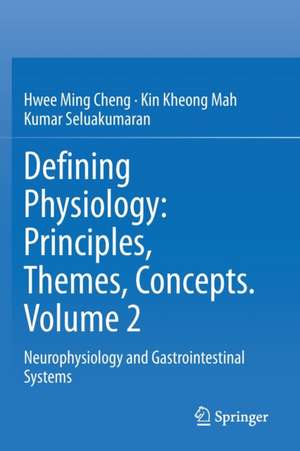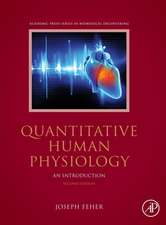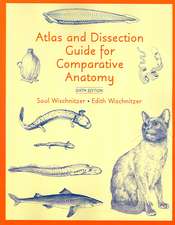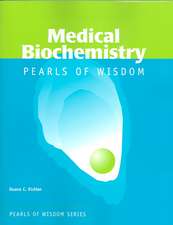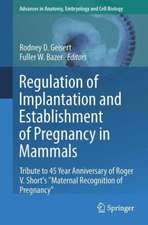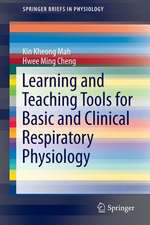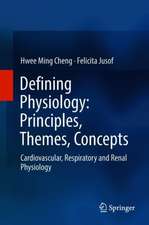Defining Physiology: Principles, Themes, Concepts. Volume 2: Neurophysiology and Gastrointestinal Systems
Autor Hwee Ming Cheng, Kin Kheong Mah, Kumar Seluakumaranen Limba Engleză Paperback – 13 ian 2022
This book presents an easy reference guide for those just starting out in the area of physiology and for those who are interested in clear and succinct definitions of key terms.
| Toate formatele și edițiile | Preț | Express |
|---|---|---|
| Paperback (1) | 769.49 lei 6-8 săpt. | |
| Springer International Publishing – 13 ian 2022 | 769.49 lei 6-8 săpt. | |
| Hardback (1) | 638.99 lei 38-44 zile | |
| Springer International Publishing – 13 ian 2021 | 638.99 lei 38-44 zile |
Preț: 769.49 lei
Preț vechi: 809.99 lei
-5% Nou
Puncte Express: 1154
Preț estimativ în valută:
147.24€ • 153.74$ • 121.59£
147.24€ • 153.74$ • 121.59£
Carte tipărită la comandă
Livrare economică 15-29 aprilie
Preluare comenzi: 021 569.72.76
Specificații
ISBN-13: 9783030622879
ISBN-10: 3030622878
Ilustrații: XII, 112 p. 42 illus., 20 illus. in color.
Dimensiuni: 155 x 235 mm
Greutate: 0.19 kg
Ediția:1st ed. 2020
Editura: Springer International Publishing
Colecția Springer
Locul publicării:Cham, Switzerland
ISBN-10: 3030622878
Ilustrații: XII, 112 p. 42 illus., 20 illus. in color.
Dimensiuni: 155 x 235 mm
Greutate: 0.19 kg
Ediția:1st ed. 2020
Editura: Springer International Publishing
Colecția Springer
Locul publicării:Cham, Switzerland
Cuprins
Salivary gland: Savilon.- Oesophageal sphincters: Upper oesophageal sphincter and lower oesophageal sphincter.- Stomach as an Acid Producer.- Homeostasis of gastric acid secretion: neurocrine, paracrine and endocrine system, proton pump inhibitors. Alkaline tide.- Gastric mucosal barrier, Helicobacter pylori.- Gastric motility: (Migrating Motor Complex, Receptive Relaxation, Accommodation, Retropulsion).- Gastric Emptying.- Gastrointestinal Rhythmic Contractions Electrical Basis: Slow wave potential.- Migratory Motor Complex (or migrating myoelectric complex), MMC, Motilin.- Motility: Peristalsis, Segmentation, Haustration and Mass movement.- Motility: Peristalsis, Segmentation, Haustration and Mass movement.- Recycling of bile salts: Enterohepatic Circulation (EHC).- Intestinal Fluid Handling: Absorption.- Intestinal Fluid Handling: Secretion.- Pancreatic Exocrine function: Pancreatic acinar cell in pancreatic secretion, cholecystokinin (CCK), Auto- digestion.- Pancreatic Exocrine function: Pancreatic ductal cell, CFTR chloride channel. Secretin.- Carbohydrate Digestion: Small intestine as the site of digestion and absorption for dietary carbohydrate.- Fat digestion: Bile salt, emulsification, micelles, lipases, chylomicrons.- Protein Digestion.- Protein Absorption.- Defecation Reflex: Parasympathetic defecation reflex, intrinsic myenteric defection reflex.- Resting Membrane Potential (RMP).- Equilibrium Potential.- Membrane conductance .- Action Potential.- Neuronal excitability.- Neuronal refractory period.- Initiation zone .- Saltatory conduction.- Firing rate.- Post-synaptic potentials.- Synaptic delay.- Summation.- Neurotransmitter.- Presynaptic inhibition.- Adequate stimulus.- Stimulus transduction.- Stimulus coding.- Adaptation.- Sensory discrimination (acuity).- Motor neurons.- Neuromuscular junction.- Proprioception.- Spinal reflex.- Alpha-gamma coactivation.
Notă biografică
Dr. Cheng Hwee Ming graduated from University of Liverpool with a Joint Honors (Biochemistry/Cell Biology, 1980) and PhD (Immunology, 1983). He has taught Physiology at the Universiti Malaya in Kuala Lumpur since 1985. Dr Cheng has an interest in understanding how students think, learn and in helping them unmask misconceptions in Physiology. His academic books include ' Thinking Through Physiology ' and the Springer's ‘Physiology Question-based Learning’ title. Dr Cheng is also the initiator of the annual International Physiology Quiz now in its 18th year, each event participated by more than 90 medical schools from over 20 countries. He is married to Gaik Cheng, a general practitioner, and they have two children, Timothy, Ruth and a grandson, Caleb.
Dr. Kumar Seluakumaran received his medical degree from University of Malaya in 2002 and his Ph.D from the University of Western Australia in 2007. He has since been working as a senior lecturer at the Department of Physiology, Faculty of Medicine, University of Malaya. He has been teaching neurophysiology to undergraduate and postgraduate students for the past 13 years. His research interest is in the area of auditory neuroscience and he has published peer-reviewed articles related to central auditory neuronal responses, audiology and psychoacoustics.
Assoc Prof Dr Mah Kin Kheong graduated from University Malaya in 1985 and later trained as an anaesthetist in Malaysia and Australia, obtaining his Masters in Anaesthesiology from University Malaya in 1992 and his Fellowship from the Australian and New Zealand College of Anaesthetist in 1994. He was inducted as a Fellow in the Academy of Medicine in Malaysia in 2007. He teaches at the Royal College of Medicine Perak, University Kuala Lumpur. He was the Head of Physiology and the current Deputy Dean of the college. He is also a trainer and examiner in the Conjoint Master of Anaesthesia programme in Malaysia.
Textul de pe ultima copertă
This second volume of Defining Physiology: Principles, Themes, Concepts. continues on the same format as the first.
In this new release, a selection of 44 essential topics in each major organ system is defined, then major themes, concept and principles surrounding these words in their physiologic scenarios are elaborated. For each keyword, a question is posed at the end of the text to test for a better understanding of the associated physiology of nervous and gastrointestinal systems.
This book presents an easy reference guide for those just starting out in the area of physiology and for those who are interested in clear and succinct definitions of key terms.
This book presents an easy reference guide for those just starting out in the area of physiology and for those who are interested in clear and succinct definitions of key terms.
Caracteristici
Provides definitions of essential key words with conceptual elaborations on Nervous and Gastrointestinal Systems Offers figures to enhance each definition Is a useful companion to the “Physiology-Question Based Learning” titles
